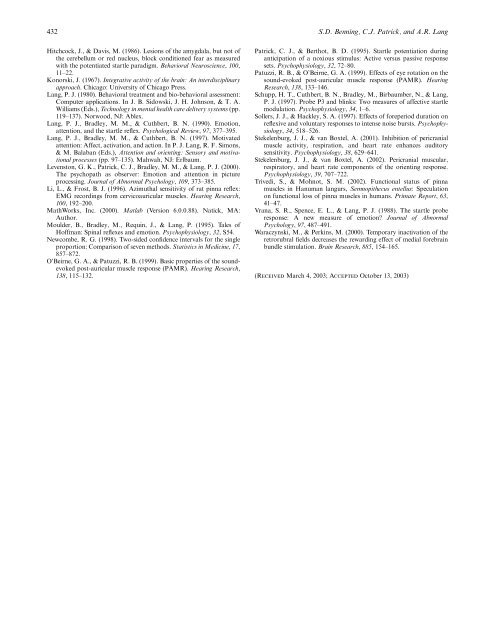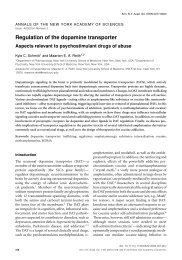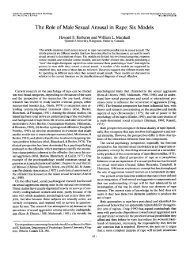Emotion and <strong>the</strong> post-auricular <strong>reflex</strong> 431 2000) and with motor deficits arising from Parkinson’s disease in humans (Heim et al., 2002). An alternative possibility is that increased post-auricular reactivity reflects enhanced orienting to <strong>the</strong> noise probe stimulus. Indeed, <strong>the</strong>re is evidence that unexpected noises can evoke observable movement <strong>of</strong> <strong>the</strong> post-auricular (pinna) muscle in primates in whom this muscle serves more than a vestigial function. Naturalistic observations <strong>of</strong> Hanuman langurs, a lower primate species, have revealed that in adult males, loud and surprising sounds yield brief (i.e., 0.2–0.3 s) movements <strong>of</strong> both <strong>the</strong> pinna and <strong>the</strong> head in <strong>the</strong> direction <strong>of</strong> <strong>the</strong> noise (Trivedi & Mohnot, 2002), suggesting that <strong>the</strong> pinna <strong>reflex</strong> serves an orienting function in this primate species. It may be that states <strong>of</strong> attentional engagement, such as those associated with viewing <strong>of</strong> pleasurable pictures, facilitate this phasic <strong>reflex</strong>ive orienting reaction. However, because pleasant and unpleasant pictures engage more attention than neutral (Lang et al., 1990, 1997), <strong>the</strong> predicted attentional pattern would have been one <strong>of</strong> <strong>postauricular</strong> <strong>reflex</strong> inhibition for both affective categories compared to neutral. Fur<strong>the</strong>rmore, juveniles and females <strong>of</strong> this species exhibit greater short-duration pinna movements primarily during play, feeding, and foraging for food (Trivedi & Mohnot, 2002), suggesting heightened responsiveness <strong>of</strong> this <strong>reflex</strong>ive system specifically during pleasurable activities. Never<strong>the</strong>less, <strong>the</strong>re is evidence that unpleasant pictures also engage attention (Lang et al., 1997), so it is possible that some types <strong>of</strong> aversive pictures might likewise facilitate <strong>the</strong> <strong>postauricular</strong> <strong>reflex</strong>. The current study focused on threat and physical attack pictures that tend to be perceived as fearful. Modulatory Ames, K. A., Merritt, N. P., Stout, K., & Hetrick, W. P. (2003). Differential effects <strong>of</strong> affective <strong>modulation</strong> on orbicularis and <strong>postauricular</strong> indices <strong>of</strong> startle. Psychophysiology, 40, S22. Anthony, B. J., & Graham, F. K. (1985). Blink <strong>reflex</strong> modification by selective attention: Evidence for <strong>the</strong> <strong>modulation</strong> <strong>of</strong> automatic processing. Biological Psychology, 21, 43–59. Benning, S. D., Patrick, C. J., Hicks, B., Blonigen, D., & Lang, A. R. (2001). Affective <strong>modulation</strong> <strong>of</strong> blink startle and post-auricular <strong>reflex</strong>es to noise probes. Psychophysiology, 38, S24. Bonnet, M., Bradley, M. M., Lang, P. J., & Requin, J. (1995). Modulation <strong>of</strong> spinal <strong>reflex</strong>es: Arousal, pleasure, action. Psychophysiology, 32, 367–372. Bradley, M. M., Codispoti, M., Cuthbert, B. N., & Lang, P. J. (2001). Emotion and motivation I: Defensive and appetitive reactions in picture processing. Emotion, 1, 276–298. Bradley, M. M., Cuthbert, B. N., & Lang, P. J. (1993). Emotion, novelty, and <strong>the</strong> startle <strong>reflex</strong>: Habituation in humans. Behavioral Neuroscience, 107, 970–980. Bradley, M. M., Drobes, D., & Lang, P. J. (1996). A probe for all reasons: Reflex and RTmeasures in perception. Psychophysiology, 33, S25. Braff, D. L., Geyer, M. A., & Swerdlow, N. R. (2001). Human studies <strong>of</strong> prepulse inhibition <strong>of</strong> startle: Normal subjects, patient groups, and pharmacological studies. Psychopharmacology, 156, 234–258. Cassella, J. V., & Davis, M. (1986). Habituation, prepulse inhibition, fear conditioning, and drug <strong>modulation</strong> <strong>of</strong> <strong>the</strong> acoustically elicited pinna <strong>reflex</strong> in rats. Behavioral Neuroscience, 100, 39–44. Cassella, J. V., Harty, P. T., & Davis, M. (1986). Fear conditioning, prepulse inhibition and drug <strong>modulation</strong> <strong>of</strong> a short latency startle response measured electromyographically from neck muscles in <strong>the</strong> rat. Physiology and Behavior, 36, 1187–1191. Center for <strong>the</strong> Study <strong>of</strong> Emotion and Attention [CSEA-NIMH]. (1999). The international affective picture system: Digitized photographs. Gainesville, FL: The Center for Research in Psychophysiology, University <strong>of</strong> Florida. REFERENCES effects may differ for o<strong>the</strong>r aversive contents, such as sadness, disgust, or mutilation pictures. It will also be important in future research to examine effects for o<strong>the</strong>r pleasurable picture contents (e.g., babies, animals, food). In addition, <strong>the</strong>re are o<strong>the</strong>r limitations <strong>of</strong> <strong>the</strong> current study that need to be addressed before firm conclusions can be advanced regarding <strong>the</strong> post-auricular <strong>reflex</strong> as an index <strong>of</strong> emotion. The current sample included only men; thus, it will be important to replicate <strong>the</strong>se findings in women. Fur<strong>the</strong>rmore, it will be important to assess <strong>modulation</strong> <strong>of</strong> <strong>the</strong> post-auricular <strong>reflex</strong> in emotional processing tasks o<strong>the</strong>r than picture viewing. A key question is whe<strong>the</strong>r potentiation <strong>of</strong> <strong>the</strong> post-auricular <strong>reflex</strong> would be observed in appetitive conditioning or reward anticipation contexts, as is true for startle in corresponding aversive paradigms (e.g., Hamm, Greenwald, Bradley, & Lang, 1993; Patrick & Berthot, 1995). Affirmative findings would lend support to <strong>the</strong> idea that <strong>the</strong> <strong>postauricular</strong> <strong>reflex</strong> is primed during appetitive states. Finally, in light <strong>of</strong> recent data indicating that hedonic valence and approach– withdrawal aspects <strong>of</strong> emotion are dissociable, it would be informative to assess whe<strong>the</strong>r <strong>the</strong> post-auricular <strong>reflex</strong> is enhanced or inhibited during a negatively valent approach state (e.g., anger; Harmon-Jones & Sigelman, 2001). Notwithstanding <strong>the</strong>se limitations, <strong>the</strong> findings <strong>of</strong> our study are intriguing. They suggest that <strong>the</strong> post-auricular <strong>reflex</strong>, which is evoked by <strong>the</strong> same acoustic probe as <strong>the</strong> startle <strong>reflex</strong>, may provide an index <strong>of</strong> appetitive system activation. If so, this <strong>reflex</strong>ive measure could provide a valuable tool for studying basic appetitive processes and investigating deficiencies in positive affect associated with psychopathology. Cook, E. W. III, Atkinson, L. S., & Lang, K. G. (1987). Stimulus control and data acquisition for IBM PCs and compatibles. Psychophysiology, 2, 726–727. Cuthbert, B. N., Bradley, M. M., & Lang, P. J. (1996). Probing picture perception: Activation and emotion. Psychophysiology, 33, 103–111. Davis, M., Gendelman, D. S., Tischler, M. D., & Gendelman, P. M. (1982). A primary acoustic startle circuit: Lesion and stimulation studies. Journal <strong>of</strong> Neuroscience, 2, 791–805. Davis, M., Walker, D. L., & Lee, Y. (1999). Neurophysiology and neuropharmacology <strong>of</strong> startle and its affective <strong>modulation</strong>. In M. E. Dawson, M. E. Schell, & A. H. Bohmelt (Eds.), Startle modification: Implications for neuroscience, cognitive science, and clinical science (pp. 95–117). New York: Cambridge University Press. Graham, F. K. (1975). The more or less startling effects <strong>of</strong> weak prestimulation. Psychophysiology, 2, 238–247. Gray, H. (1901/1995). Anatomy: Descriptive and surgical (15th edn). New York: Barnes and Noble Books, Inc. Hackley, S. A. (1993). An evaluation <strong>of</strong> <strong>the</strong> automaticity <strong>of</strong> sensory processing using event-related potentials and brain-stem <strong>reflex</strong>es. Psychophysiology, 30, 415–428. Hackley, S. A., Woldorff, M., & Hillyard, S. A. (1987). Combined use <strong>of</strong> micro<strong>reflex</strong>es and event-related brain potentials as measures <strong>of</strong> auditory selective attention. Psychophysiology, 24, 632–647. Hamm, A. O., Greenwald, M. K., Bradley, M. M., & Lang, P. J. (1993). <strong>Emotional</strong> learning, hedonic change, and <strong>the</strong> startle probe. Journal <strong>of</strong> Abnormal Psychology, 102, 453–465. Harmon-Jones, E., & Sigelman, J. (2001). State anger and prefrontal brain activity: Evidence that insult-related relative left-prefrontal activation is associated with experienced anger and aggression. Journal <strong>of</strong> Personality and Social Psychology, 80, 797–803. Heim, C., Sova, L., Kurz, T., Kolasiewicz, W., Schwegler, H., & Sontag, K.-H. (2002). Partial loss <strong>of</strong> dopaminergic neurons in <strong>the</strong> substantia nigra, ventrotegmental area and <strong>the</strong> retrorubral area – Model <strong>of</strong> <strong>the</strong> early beginning <strong>of</strong> Parkinson’s symptomatology? Journal <strong>of</strong> Neural Transmission, 109, 691–709.
432 S.D. Benning, C.J. Patrick, and A.R. Lang Hitchcock, J., & Davis, M. (1986). Lesions <strong>of</strong> <strong>the</strong> amygdala, but not <strong>of</strong> <strong>the</strong> cerebellum or red nucleus, block conditioned fear as measured with <strong>the</strong> potentiated startle paradigm. Behavioral Neuroscience, 100, 11–22. Konorski, J. (1967). Integrative activity <strong>of</strong> <strong>the</strong> brain: An interdisciplinary approach. Chicago: University <strong>of</strong> Chicago Press. Lang, P. J. (1980). Behavioral treatment and bio-behavioral assessment: Computer applications. In J. B. Sidowski, J. H. Johnson, & T. A. Williams (Eds.), Technology in mental health care delivery systems (pp. 119–137). Norwood, NJ: Ablex. Lang, P. J., Bradley, M. M., & Cuthbert, B. N. (1990). Emotion, attention, and <strong>the</strong> startle <strong>reflex</strong>. Psychological Review, 97, 377–395. Lang, P. J., Bradley, M. M., & Cuthbert, B. N. (1997). Motivated attention: Affect, activation, and action. In P. J. Lang, R. F. Simons, & M. Balaban (Eds.), Attention and orienting: Sensory and motivational processes (pp. 97–135). Mahwah, NJ: Erlbaum. Levenston, G. K., Patrick, C. J., Bradley, M. M., & Lang, P. J. (2000). The psychopath as observer: Emotion and attention in picture processing. Journal <strong>of</strong> Abnormal Psychology, 109, 373–385. Li, L., & Frost, B. J. (1996). Azimuthal sensitivity <strong>of</strong> rat pinna <strong>reflex</strong>: EMG recordings from cervicoauricular muscles. Hearing Research, 100, 192–200. MathWorks, Inc. (2000). Matlab (Version 6.0.0.88). Natick, MA: Author. Moulder, B., Bradley, M., Requin, J., & Lang, P. (1995). Tales <strong>of</strong> H<strong>of</strong>fman: Spinal <strong>reflex</strong>es and emotion. Psychophysiology, 32, S54. Newcombe, R. G. (1998). Two-sided confidence intervals for <strong>the</strong> single proportion: Comparison <strong>of</strong> seven methods. Statistics in Medicine, 17, 857–872. O’Beirne, G. A., & Patuzzi, R. B. (1999). Basic properties <strong>of</strong> <strong>the</strong> soundevoked post-auricular muscle response (PAMR). Hearing Research, 138, 115–132. Patrick, C. J., & Berthot, B. D. (1995). Startle potentiation during anticipation <strong>of</strong> a noxious stimulus: Active versus passive response sets. Psychophysiology, 32, 72–80. Patuzzi, R. B., & O’Beirne, G. A. (1999). Effects <strong>of</strong> eye rotation on <strong>the</strong> sound-evoked post-auricular muscle response (PAMR). Hearing Research, 138, 133–146. Schupp, H. T., Cuthbert, B. N., Bradley, M., Birbaumber, N., & Lang, P. J. (1997). Probe P3 and blinks: Two measures <strong>of</strong> affective startle <strong>modulation</strong>. Psychophysiology, 34, 1–6. Sollers, J. J., & Hackley, S. A. (1997). Effects <strong>of</strong> foreperiod duration on <strong>reflex</strong>ive and voluntary responses to intense noise bursts. Psychophysiology, 34, 518–526. Stekelenburg, J. J., & van Boxtel, A. (2001). Inhibition <strong>of</strong> pericranial muscle activity, respiration, and heart rate enhances auditory sensitivity. Psychophysiology, 38, 629–641. Stekelenburg, J. J., & van Boxtel, A. (2002). Pericranial muscular, respiratory, and heart rate components <strong>of</strong> <strong>the</strong> orienting response. Psychophysiology, 39, 707–722. Trivedi, S., & Mohnot, S. M. (2002). Functional status <strong>of</strong> pinna muscles in Hanuman langurs, Semnopi<strong>the</strong>cus entellus: Speculation on functional loss <strong>of</strong> pinna muscles in humans. Primate Report, 63, 41–47. Vrana, S. R., Spence, E. L., & Lang, P. J. (1988). The startle probe response: A new measure <strong>of</strong> emotion? Journal <strong>of</strong> Abnormal Psychology, 97, 487–491. Waraczynski, M., & Perkins, M. (2000). Temporary inactivation <strong>of</strong> <strong>the</strong> retrorubral fields decreases <strong>the</strong> rewarding effect <strong>of</strong> medial forebrain bundle stimulation. Brain Research, 885, 154–165. (Received March 4, 2003; Accepted October 13, 2003)










